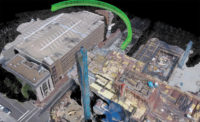It seems that when Smart Cities are discussed, more emphasis is always placed on the "new city out of the ground" phenomena, and not on our existing cities and buildings.
The new technology that can be used to reduce the power consumption and carbon footprint of new "out of the ground" Smart Cities is exciting, but it is also encouraging to see the vast opportunities we have to improve the performance of the myriad buildings in the cities we already occupy.
I like to look at it from the microcosmic view, building-by-building. A building represents a community or place that encapsulates, on a small scale, the characteristic qualities or features of the larger entity—the city. As city infrastructure becomes smarter and reduces the strain on resources, the individual building infrastructure also will have to follow suit and become smarter to lower energy usage.
So what does it mean to make an existing building smarter?
The technology exists today to keep existing buildings continuously retro-commissioned and assure that the energy efficient design and low carbon footprint of new sustainable construction is maintained after the buildings are commissioned. Data and connectivity is the “technology driver” and the key to providing information on how efficiently buildings are performing, based on the needs and wellness of the occupants. The smart building provides infrastructure to support the data mining that extracts real-time information needed to keep the building operational and enhance the occupant experience. So why all the concern about improving existing building infrastructure?
- It is predicted that by 2030 more than 60% of commercial floor space will be in buildings built prior to 2008 (Annual Energy Outlook 2008) Buildings are the largest contributor to global carbon emissions, accounting for about 40% of the world’s total carbon footprint (Energy Efficiency in Buildings, World Business Council for Sustainable Development).
- The United Nations Intergovernmental Panel on Climate Change found that the largest energy- and carbon-saving potential in 2030 will be in existing buildings, through retrofit and renovation.
- A Department of Energy study evaluating energy efficiency potential in existing commercial buildings indicated that a reasonable range of economic savings in existing commercial buildings is between 10% and 20% of current energy use.
- There are about 5.6 million existing commercial buildings in the United States. That’s why the microscopic building-by-building view is so important. Those building microcosms add up to an enormous impact.
If you do the math, it is estimated that by turning our existing buildings into smarter, more energy efficient buildings, we could save up to $25 billion in energy costs every year.
The research group Navigant, which conducts in-depth analysis of global clean technology markets, predicts global revenue for commercial building automation will grow from $58 billion in 2013 to $91.9 billion in 2023.
IDC Energy Insights predicts that spending on smart buildings could advance at a compounded annual rate of 23% though 2019. The inescapable conclusion is that retrofitting existing buildings with smart technology will account for a significant share of smart building investment and deployments in the years ahead.
To sum it up, the shift from a collection of low-voltage building controls system silos to converged systems technology and cloud-based services capable of collecting and analyzing data, will provide existing buildings a “futureproof” infrastructure. There will be less emphasis on physical connections and more on access to virtual connections.
As data sources rise exponentially through the use of Big Data and the Internet of Things (IoT), the challenges in developing technology to efficiently operate existing buildings will include working toward standard configurations and data-tagging formats that support data mining extraction and address the issues of cyber-security.
And last but not least, the rise of the green- and high-performance building movement will place a new emphasis on the importance of the smart building phenomena to keep the buildings and our cities operating efficiently, to maintain the carbon footprint as designed, and to reduce greenhouse gas emissions.
Which brings us full circle: A collection of smart buildings, managed through a converged network that has the infrastructure to support data mining and the analytical tools to extract information to retain building operations as designed, is, , a big part of the holistic Infrastructure required to support the Smart City macrocosm.
Thomas Grimard, an associate partner at Syska Hennessy Group, leads the organization’s Building Management Systems team. He and has more than 30 years’ of experience designing and implementing smart and sustainable building systems.


Post a comment to this article
Report Abusive Comment